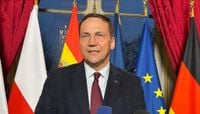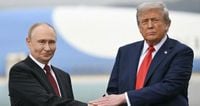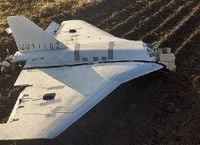Peace in Eastern Europe seems as elusive as ever, despite a flurry of diplomatic activity and mounting international concern. On Friday, September 12, 2025, the Kremlin announced that peace talks between Russia and Ukraine are now officially on pause, casting a shadow over US President Donald Trump’s latest efforts to broker an end to the three-and-a-half-year war. Trump, who has made a high-profile push—including hosting Russian President Vladimir Putin in Alaska—to bring the conflict to a close, has so far struggled to gain traction, with Moscow pressing ahead with its military campaign and new tensions erupting on NATO’s eastern flank.
Speaking to reporters in Moscow, Kremlin spokesman Dmitry Peskov acknowledged the stalemate. “Our negotiators have the opportunity to communicate through channels. But for now, it is probably more accurate to talk about a pause,” Peskov said, according to AFP. He added, “You can't wear rose-tinted glasses and expect that the negotiation process will yield immediate results.” The reality on the ground supports his caution: Russia has escalated its attacks, launching its largest aerial assault last week that killed several people and set ablaze a government building in Kyiv.
Three rounds of direct peace talks in Istanbul have yielded little more than prisoner swaps, with both sides sticking to hardline positions. Russia continues to demand that Ukraine cede the entire Donbas region—territory Moscow already partially controls—while Kyiv has flatly rejected any territorial concessions. Instead, Ukrainian officials have called for European troops to be deployed as peacekeepers, a proposal the Kremlin has dismissed as unacceptable.
Amid the diplomatic deadlock, a new crisis flared on Wednesday, September 10, when Poland reported that parts of 17 Russian-made drones were recovered in its eastern territory after a dramatic incursion into Polish airspace. No injuries or major damage were reported, but the event sent shock waves through European capitals and was quickly labeled by the European Union as a test of NATO’s resolve. Polish authorities described the incident as a deliberate act of aggression, sharply contradicting President Trump’s more conciliatory assessment.
Polish Prime Minister Donald Tusk spoke out forcefully on Friday, stating, “We would also wish that the drone attack on Poland was a mistake. But it wasn't. And we know it.” His remarks, delivered on X (formerly Twitter), left little doubt about Warsaw’s view of Moscow’s intentions. According to Polish Deputy Prime Minister Radek Sikorski, the breach was not an accident. “Poland’s airspace was breached 19 times by drones manufactured in Russia. The assessment of Polish and Nato air forces is that they did not veer off course but were targeted,” Sikorski said, as reported by The US Sun. He went further, accusing the Kremlin of mocking President Trump’s peace efforts.
Military sources told The US Sun that the drone attack appeared to be testing Poland’s radar defenses. Three drones were shot down, while others crashed near the borders with Ukraine and Belarus. Reports also suggest that Russian forces have used Polish and Lithuanian SIM cards in their drones to connect to local mobile masts for navigation, a tactic that underscores the sophistication—and audacity—of the operation.
Lithuania, Ukraine, and Germany’s Chancellor Friedrich Merz joined Poland in condemning the attack as deliberate. The incident has deepened anxieties about the war’s potential to spill over into NATO territory, a scenario that could have dramatic consequences for the alliance and the region. Ukrainian President Volodymyr Zelensky weighed in, urging Western leaders to respond decisively. “Only united European forces can give real protection. Unfortunately, so far, Russia has not yet faced a tough reaction from global leaders,” Zelensky said, according to The US Sun.
In the midst of these escalating tensions, President Trump’s strategy has come under increasing scrutiny. While his administration has launched an intense diplomatic drive and sought to position the US as a peacemaker, skepticism abounds in Europe. Trump’s remark to reporters on Thursday that the drone incursion into Poland “could have been a mistake” was met with incredulity in Warsaw and other European capitals, where officials see the attack as a calculated provocation by Moscow.
Yet not all of Europe is united in its assessment of Trump’s efforts. In a lengthy phone call on Thursday, September 11, Hungarian Minister of Foreign Affairs Péter Szijjártó and US Secretary of State Marco Rubio discussed the ongoing war and Trump’s peace initiative. According to Szijjártó, Rubio assured him that “President Trump will not give up” on finding a way to settle the conflict. Szijjártó was effusive in his praise, declaring, “Trump is the only leader with the strength to bring peace back to Central Europe, and unlike some European politicians, Hungary stands firmly behind his mission.” He also noted that Hungary’s relationship with the US had entered “a new phase of friendship and mutual respect,” citing six US investments in Hungary since Trump took office and new cooperation on American small modular nuclear reactor technology to ensure Hungary’s energy security.
The US Department of State, for its part, released a statement after the call, emphasizing the importance of supporting a peace process “centered on ending the Russia–Ukraine war through a lasting negotiated settlement.” The statement also highlighted discussions on “strategic efforts to ensure energy security,” reflecting the broader stakes of the conflict for European stability and transatlantic relations.
Back in Kyiv, the mood remains grim. The recent surge in Russian attacks—including the devastating aerial assault that killed civilians and destroyed key infrastructure—has left many Ukrainians skeptical that diplomacy alone can halt Moscow’s advance. The government continues to press for greater Western support, including the deployment of European peacekeepers, but so far, the response from global leaders has been measured and cautious.
Meanwhile, the war’s reverberations are being felt well beyond the battlefield. The drone attack on Poland has reignited debates within NATO about collective defense and the alliance’s readiness to respond to new forms of hybrid warfare. The use of civilian technology—like local SIM cards in drones—raises troubling questions about the evolving nature of the conflict and the challenges of defending against unconventional threats.
As the world watches and waits, the path to peace remains uncertain. The Kremlin’s insistence on territorial concessions, Ukraine’s call for international peacekeepers, and the West’s struggle to present a united front have combined to create a diplomatic impasse. President Trump’s efforts, however energetic, have yet to produce a breakthrough. And with tensions on NATO’s borders rising, the stakes for Europe—and the world—have rarely been higher.
For now, the war grinds on, with no end in sight and the specter of wider conflict looming ever larger over the continent.


